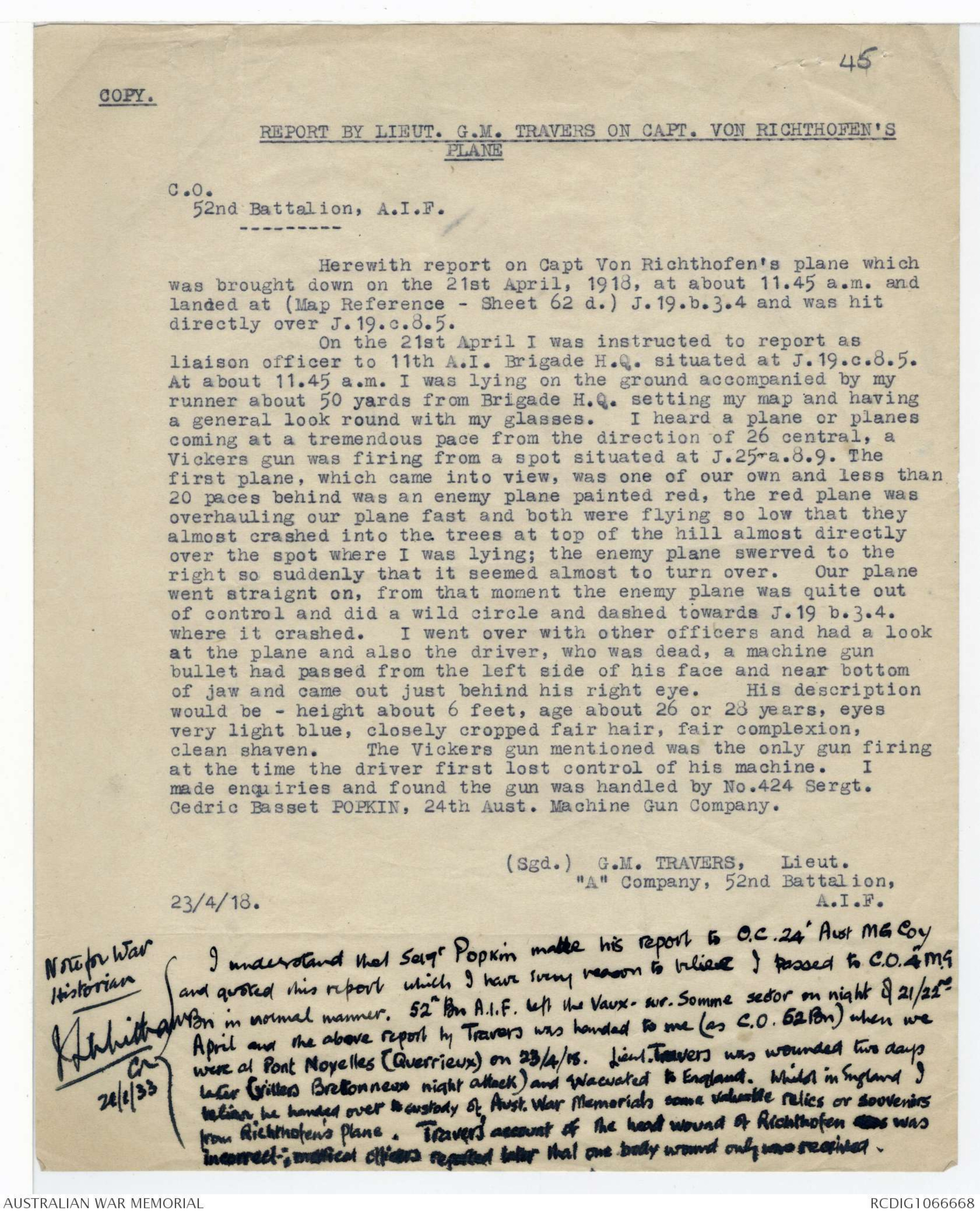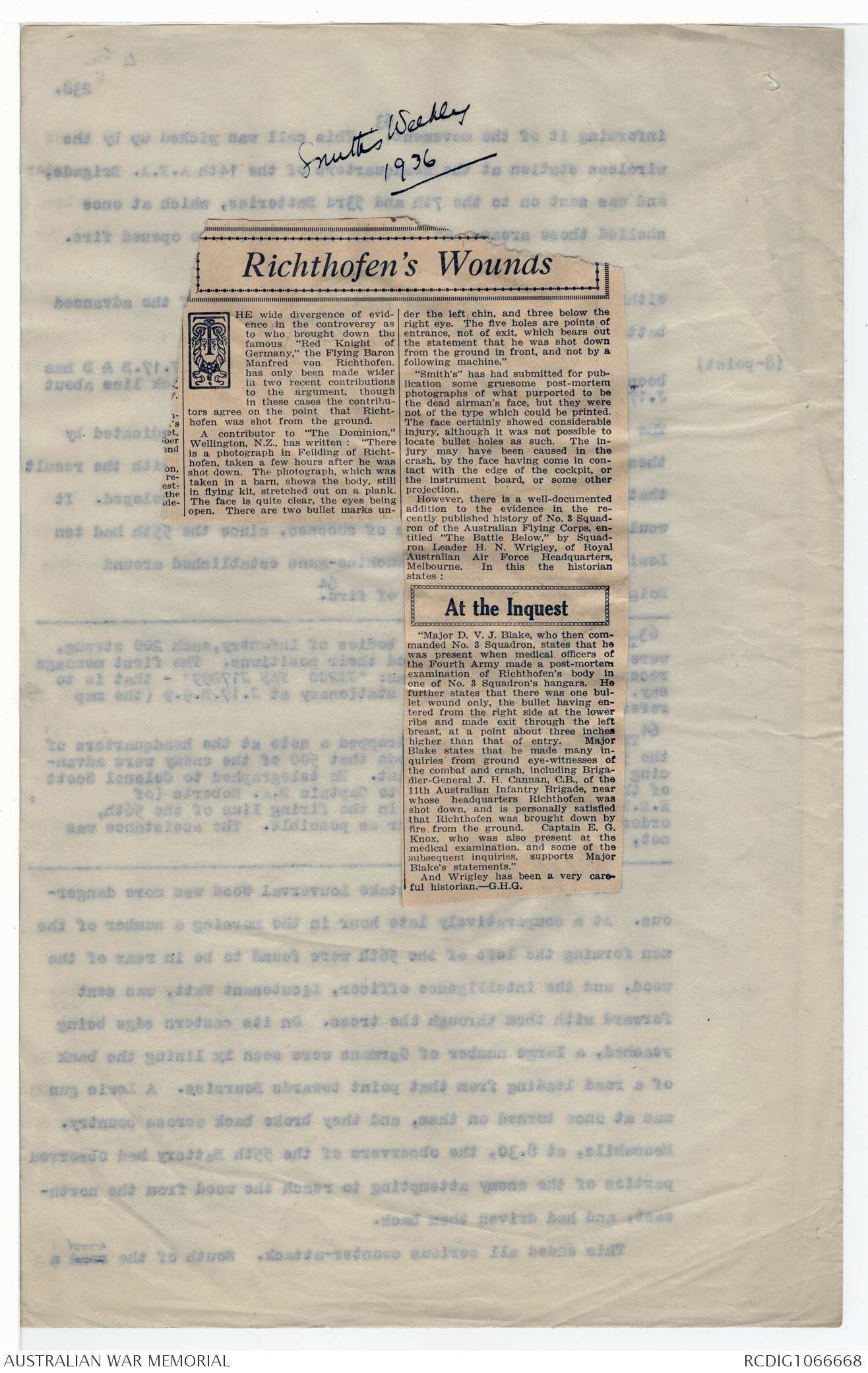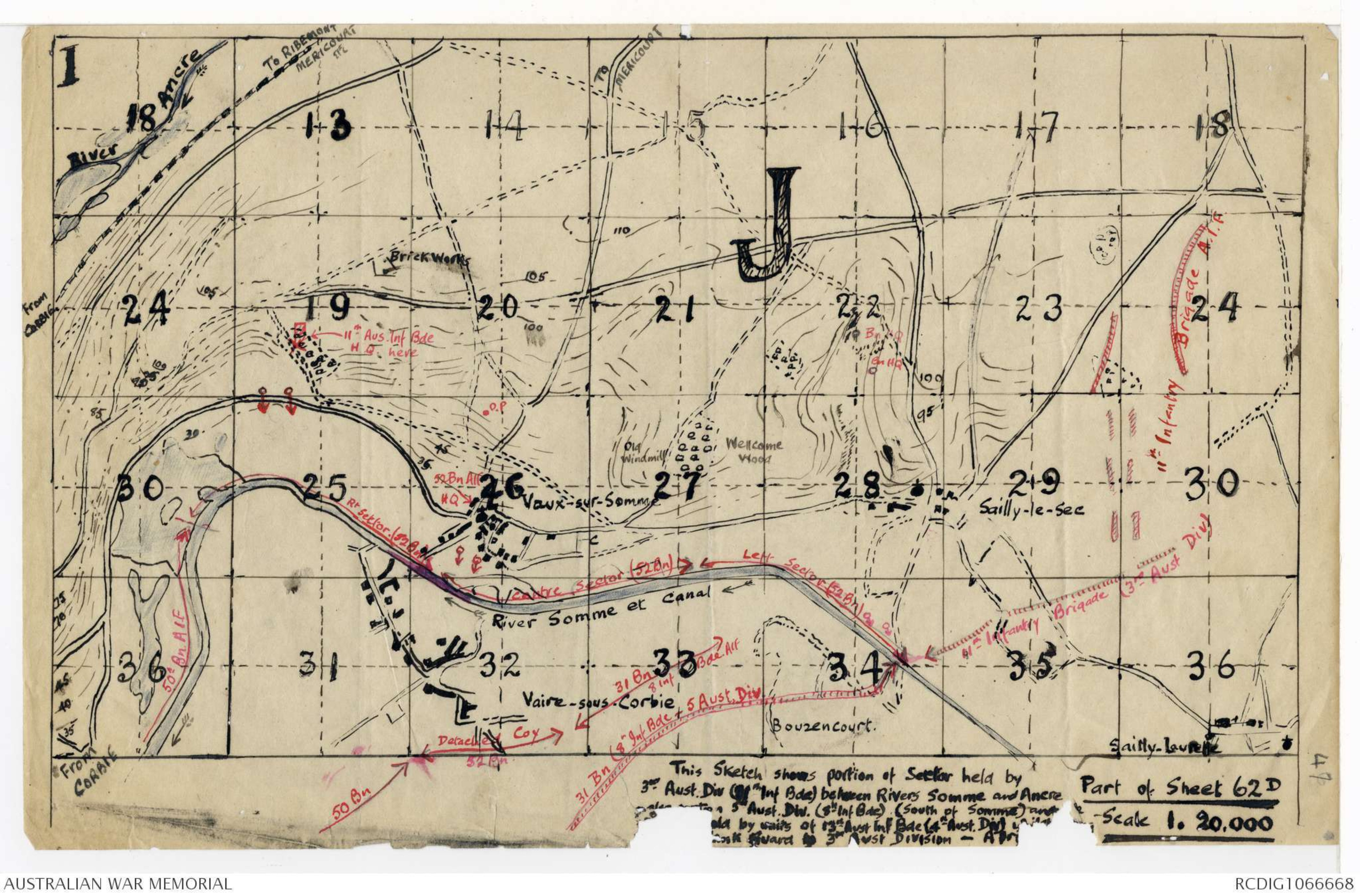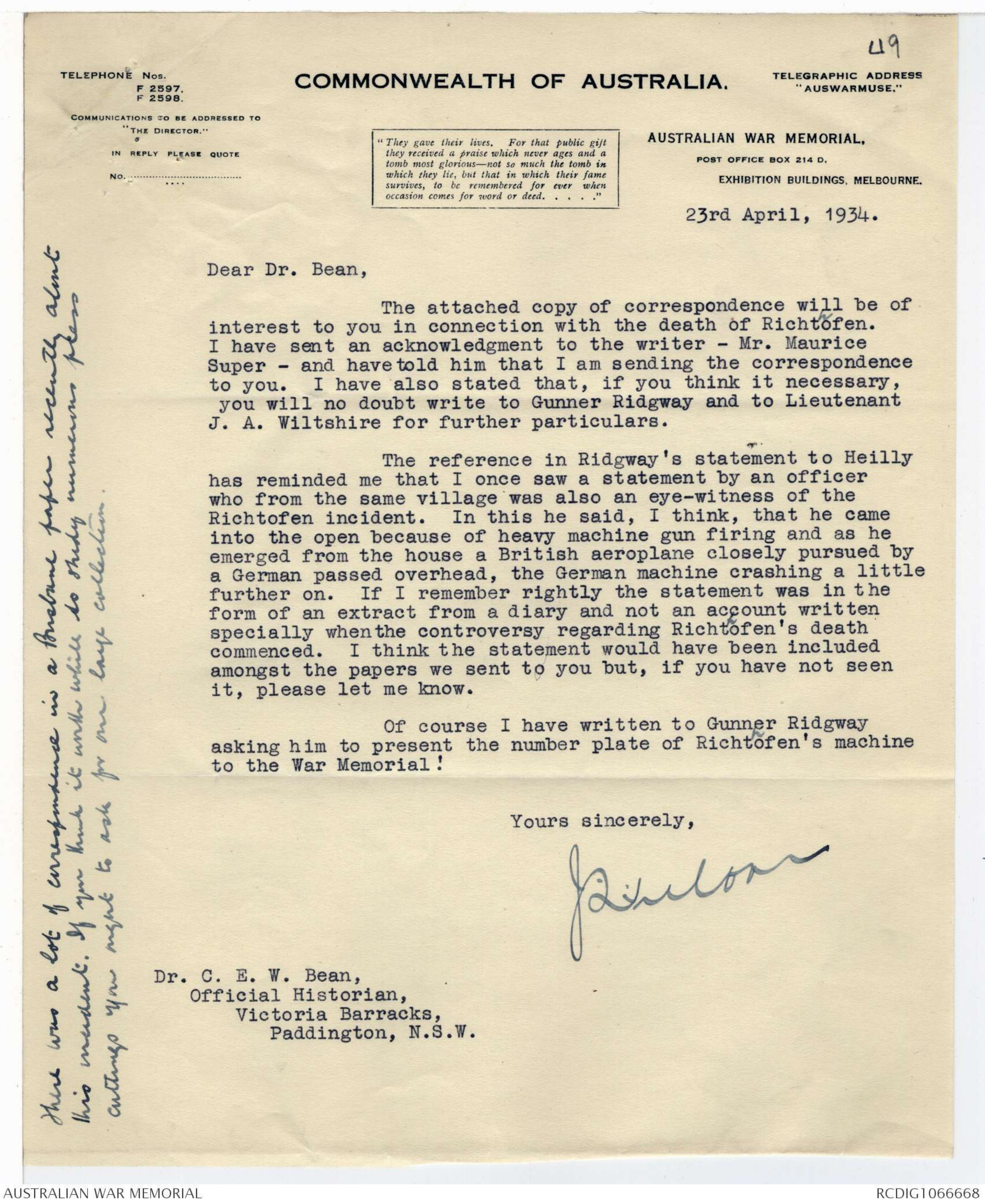Charles E W Bean, Diaries, AWM38 3DRL 606/270 PART 1/1 - 1918 - 1939 - Part 10







45
COPY.
REPORT BY LIEUT. G.M. TRAVERS ON CAPT. VON RICHTHOFEN'S
PLANE
C.O.
52nd Battalion, A.I.F.
-----------------
Herewith report on Capt Von Richthofen's plane which
was brought down on the 21st April, 1918, at about 11.45 a.m. and
landed at (Map Reference - Sheet 62 d.) J. 19. b.3.4 and was hit
directly over J. 19. c.8.5.
On the 21st April I was instructed to report as
liaison officer to 11th A.I. Brigade H.Q. situated at J. 19. c.8.5.
At about 11.45 a.m. I was lying on the ground accompanied by my
runner about 50 yards from Brigade H.Q. setting my map and having
a general look round with my glasses. I heard a plane or planes
coming at a tremendous pace from the direction of 26 central, a
Vickers gun was firing from a spot situated at J. 25 a.8.9. The
first plane, which came into view, was one of our own and less than
20 paces behind was an enemy plane painted red, the red plane was
overhauling our plane fast and both were flying so low that they
almost crashed into the trees at top of the hill almost directly
over the spot where I was lying; the enemy plane swerved to the
right so suddenly that it seemed almost to turn over. Our plane
went straight on, from that moment the enemy plane was quite out
of control and did a wild circle and dashed towards J. 19 b.3.4.
where it crashed. I went over with other officers and had a look
at the plane and also the driver, who was dead, a machine gun
bullet had passed from the left side of his face and near bottom
of jaw and came out just behind his right eye. His description
would be - height about 6 feet, age about 26 or 28 years, eyes
very light blue, closely cropped fair hair, fair complexion,
clean shaven. The Vickers gun mentioned was the only gun firing
at the time the driver first lost control of his machine. I
made enquiries and found the gun was handled by No.424 Sergt.
Cedric Basset POPKIN, 24th Aust. Machine Gun Company.
(Sgd.) G.M. TRAVERS, Lieut.
"A" Company, 52nd Battalion,
A.I.F.
23/4/18.
[*Note for War
Historian
J. L. Witham
Col
28/8/33
I understand that Segt Popkin made his report to O.C. 24th Aust MG Coy
and quoted this report which I have every reason to believe. I passed to C.O. 4th MG
Bn in normal manner. 52nd Bn A.I.F. left the Vaux-sur-Somme sector on night of 21/22nd
April and the above report by Travers was handed to me (as C.O. 52 Bn) when we
were at Pont Noyelles (Querrieux) on 23/4/18. Lieut. Travers was wounded two days
later (Villers Bretonneux night attack) and evacuated to England. Whilst in England I
believe he handed over to custody of Aust. War Memorials some valuable relics or souvenirs
from Richthofen's plane. Travers' account of the head wound of Richthofen was was
incorrect; medical officers reported later than one belly wound only was received.
46 238.
informing it of the movements. 63 This call was picked up by the
wireless station at the headquarters of the 14th A.F.A. Brigade,
and was sent on to the 7th and 53rd Batteries, which at once
shelled those areas. The 26th Heavy Battery also opened fire.
(TAKE IN SKETCH No. 82A)
Within twelve minutes the airmen dropped at one of the advanced
batteries a note:
[*(8 - point)*].
The fire directed over the enemy infantry in J.17.B & D has
been excellent. The Huns are still in a pretty thick line about
J.17.D.9.7.
The field batteries continued to fire at the area indicated by
these map references, expending in all 400 shells, with the result
that, if a counter-attack was intended, it never developed. It
would have had little chance of success, since the 55th had ten
Lewis guns and two Vickers machine-guns established around
Doignies with a clear field of fire.64
----
63 The call stated that two bodies of infantry, each 200 strong,
were advancing, and indicated their positions. The first message
received by the artillery was “JX200 FAN J17B99” - that is to
say, that 200 infantry were stationary at J.17.B.9.9. (the map
reference).
64 The airmen also at 7.20 dropped a note at the headquarters of
the 55th informing Major Woods that 500 of the enemy were advancing
on Doignies from the east. He telegraphed to Colonel Scott
of the 56th, who telephoned to Captain H.A. Roberts (of ,
N.S.W.), the senior officer in the firing line of the 56th,
ordering him to assist as far as possible. The assistance was
not, however, required.
-----
The German effort to retake Louverval Wood was more dangerous.
At a comparatively late hour in the morning a number of the
men forming the left of the 56th were found to be in rear of the
wood, and the intelligence officer, Lieutenant Watt, was sent
forward with them through the trees. On its eastern edge being
reached, a large number of Germans were seen xx lining the bank
of a road leading from that point toward Boursies. A Lewis gun
was at once turned on them, and they broke back across country.
Meanwhile, at 8.30, the observers of the 55th Battery had observed
parties of the enemy attempting to reach the wood from the north-east,
and had driven them back.
This ended all serious counter-attack. South of the road wood a
Article: Smith's Weekly 1936.
"Richthofen's Wounds:"
See original article
Map - see original document
48
7806.
27 January 1933.
H.A. Jones, Esq.,
Historical Section (Air Branch),
Committee of Imperial Defence,
Audit House,
Victoria Embankment,
London, E.C.4.
Dear Jones,
Since receiving your letter concerning Richthofen's
death, I have had the opportunity of referring the matter to
two personal friends of mine who saw the incident. Colonel
J.L. Whitham, then commanding the 52nd Battalion, saw the two
'planes as they passed over Vaux-sur-Somme travelling westwards.
They passed out of view just before the triplane crashed. He
says:-
"l am very definite on the point that two 'planes only
came down the valley. A heavy fog or river mist, with
a curtain of about 150 feet, had rested in the valley of
the Somme for several hours and prevented our view of
the air fight which we could hear very plainly overhead
and towards the east, i.e., over Sailly-le-Sec and
Sailly Laurette. Both these 'planes came from east and
downwards, and they 'flattened out' as they passed over
Vaux-sur-Somme, less than 100 feet from the valley level.
It seemed certain that both would crash into the spur
immediately west of the sharp bend in the Somme where it
turns southwards towards Corbie, but we saw the leading
'plane rise at the spur, closely followed by the
triplane. The triplane seemed to be definitely under
control of its pilot as it passed over Vaux-sur-Somme,
and it is difficult to credit the assertion that the
pilot was fatally wounded by a shot fired from the air
prior to his passing over Vaux. I cannot say whether
Richthofen was firing at the Camel at this stage - the
noise of both engines was very great - but I heard
machine-guns firing from the ground further west down
the valley."
Major Blair Wark, V.C., who was then second-in-
command of the 32nd Battalion, watched the actual shooting-down.
He tells me that beyond question there were only two aeroplanes
present - one, a British 'plane, being pursued, bynd second, a
red triplane, which was following it, firing keenly. No other
'plane was near, and there could be no possibility of the
pilot having already received such a wound as that which killed
him. Wark was of opinion that the fatal shot came from another
machine-gun than those with the 53rd Battery and 24th M.G.
Company, but definitely from one firing from the ground. A
number were firing at the 'plane.
Yours sincerely,
C.E.W. Bean.
49
TELEPHONE Nos.
F 2597.
F 2598.
TELEGRAPHIC ADDRESS
"AUSWARMUSE."
COMMONWEALTH OF AUSTRALIA.
AUSTRALIAN WAR MEMORIAL.
POST OFFICE BOX 214 D.
EXHIBITION BUILDINGS, MELBOURNE.
COMMUNICATIONS TO BE ADDRESSED TO
"THE DIRECTOR."
IN REPLY PLEASE QUOTE
No. .........................
"They gave their lives. For that public gift
they received a praise which never ages and a
tomb most glorious –not so much the tomb in
which they lie, but that in which their fame
survives, to be remembered for ever when
occasion comes for word or deed. . . . "
23rd April, 1934.
Dear Dr. Bean,
The attached copy of correspondence will be of
interest to you in connection with the death of Richthofen.
I have sent an acknowledgment to the writer - Mr. Maurice
Super - and havetold him that I am sending the correspondence
to you. I have also stated that, if you think it necessary,
you will no doubt write to Gunner Ridgway and to Lieutenant
J. A. Wiltshire for further particulars.
The reference in Ridgway's statement to Heilly
has reminded me that I once saw a statement by an officer
who from the same village was also an eye-witness of the
Richtofen incident. In this he said, I think, that he came
into the open because of heavy machine gun firing and as he
emerged from the house a British aeroplane closely pursued by
a German passed overhead, the German machine crashing a little
further on. If I remember rightly the statement was in the
form of an extract from a diary and not an account written
specially when the controversy regarding Richthofen's death
commenced. I think the statement would have been included
amongst the papers we sent to you but, if you have not seen
it, please let me know.
Of course I have written to Gunner Ridgway
asking him to present the number plate of Richthofen's machine
to the War Memorial !
Yours sincerely,
J L Treloar
Dr. C. E. W. Bean
Official Historian,
Victoria Barracks,
Paddington, N.S.W.
[*There was a lot of correspondence in a Brisbane paper recently about
this incident. If you think it worth while to study numerous press
cuttings you might to ask for our large collection.*]
50
T/MR
23rd April, 1934.
Dear Sir,
Your letter of the 10th April addressed to the Official
War Historian, Canberra, has been re-directed to this office and
reached me to-day.
The recent report in the Melbourne Herald that the
death of the German Flying Ace, Captain Von Richthofen, was
attributed by the Official Historian to a Canadian named Brown,
referred to the British Official Historian and not to the
Australian.
Chronologically the incident in which Richthofen was
killed comes within the scope of Vol. V of the Official History
of Australia in the War of 1914-1918. This volume is now being
written by Dr. Bean and it is known that he has collected a
considerable amount of data dealing with the subject. I have
therefore copied the documents which accompanied your letter
and am passing them, together with a copy of your communication,
to Dr. Bean. If he requires further information he will no
doubt communicate with Gunner Ridgway and, if he thinks it
necessary, with Lieutenant J. A. Wiltshire.
I am sure that Dr. Bean will be grateful to you for
having brought this interesting information to his notice.
Yours faithfully,
JLT
J. L. Treloar.
Director.
Maurice Super, Esq.,
Lang Lang,
Victoria.
 Sam scott
Sam scottThis transcription item is now locked to you for editing. To release the lock either Save your changes or Cancel.
This lock will be automatically released after 60 minutes of inactivity.